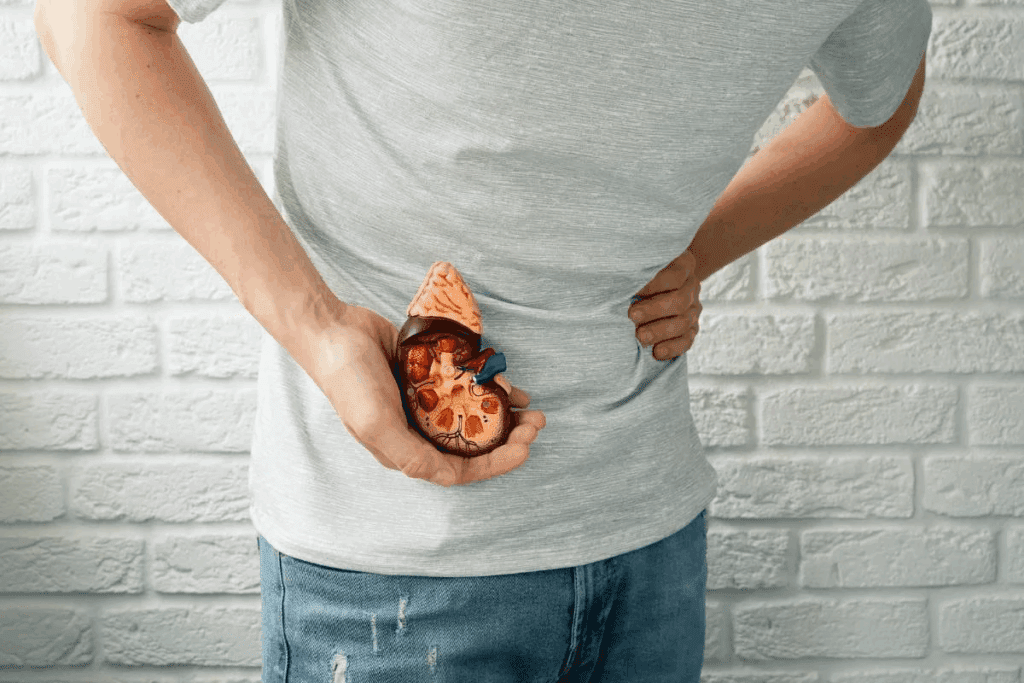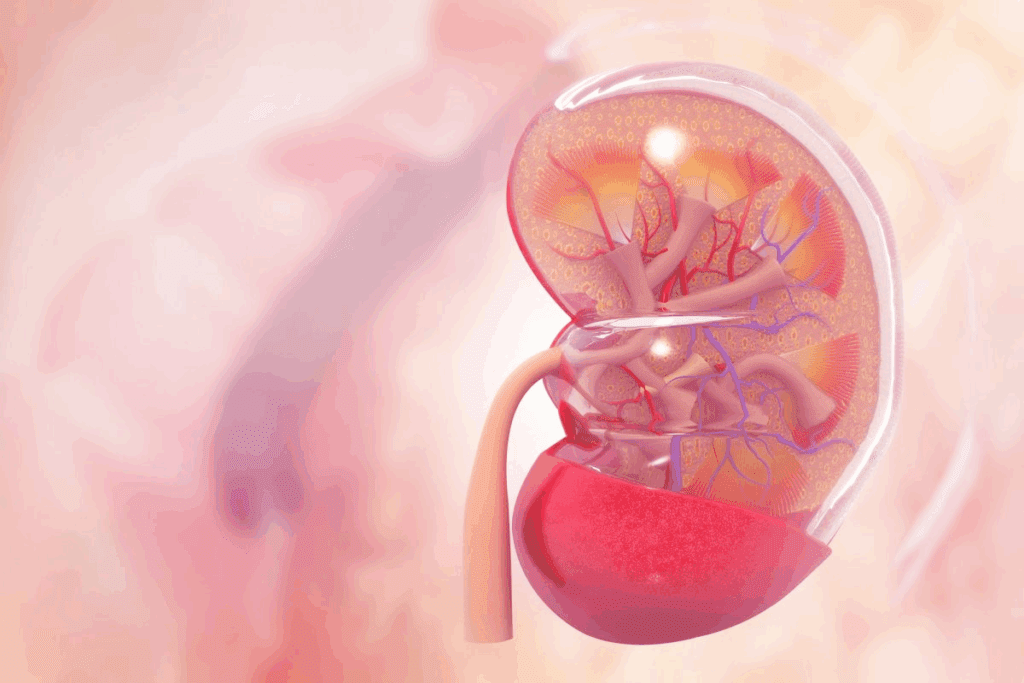Last Updated on October 31, 2025 by Bilal Hasdemir

Blood in the urine, known as hematuria, is a worrying sign, mainly when it’s linked to kidney health. At Liv Hospital, we know how vital it is to tackle this issue quickly is a bleeding kidney dangerous.
Hematuria impacts about 29 percent of adults with chronic kidney disease. This makes it a big worry for those with kidney problems. The blood in urine can come from the kidney or urinary tract. The treatment depends on where it’s coming from.
Our skilled nephrologists focus on giving detailed, patient-focused care to find out why there’s blood in the urine. It’s key to know the dangers of blood in urine with kidney disease to manage and treat it well.

It’s important to know about hematuria to understand kidney bleeding. Hematuria means blood in the urine. It can show many health problems with the kidneys.
Hematuria has two types: gross hematuria and microscopic hematuria. Gross hematuria means you can see the blood, making urine look pink, red, or cola-like. Microscopic hematuria has blood cells only seen with a microscope.
Gross hematuria is serious because it means a lot of blood loss. Seeing blood in your urine is alarming. You should get medical help right away if your urine looks different.
| Type of Hematuria | Description | Visibility |
| Gross Hematuria | Visible blood in urine, urine appears pink, red, or cola-colored | Visible to the naked eye |
| Microscopic Hematuria | Blood cells detectable only through a microscope | Not visible to the naked eye |
Blood in urine can mean kidney problems or damage to the urinary tract. Kidneys filter waste and excess fluids. Damage or disease can cause blood to leak into the urine.
Kidney damage or disease can come from infections, stones, or long-term conditions like diabetes or high blood pressure. Knowing how hematuria affects kidneys is key for early treatment.
By spotting hematuria signs and understanding its effects, people can help keep their kidneys healthy. This way, they can catch and treat problems early.

Kidney bleeding is a serious issue that needs quick attention. It’s called hematuria and can signal a major health problem. You should see a doctor right away.
Gross hematuria means you can see blood in your urine. This can cause several serious problems. These include:
If you see blood in your urine, get medical help fast. It could mean you have a serious problem.
Not treating kidney bleeding can harm your kidneys and health over time. Studies show that ongoing microscopic hematuria can lead to chronic kidney disease. Some long-term risks are:
If you see blood in your urine, see a doctor. It could be a sign of infection, kidney stones, or cancer. Early treatment is key to avoiding long-term damage and getting the best results.
Kidney bleeding, or hematuria, can happen for many reasons. These include infections and physical injuries. Knowing why it happens helps find the right treatment and avoid more problems.
Urinary tract infections (UTIs) often cause kidney bleeding. Bacteria in the urinary tract can lead to inflammation and bleeding. UTIs can affect the kidneys, bladder, and ureters.
Symptoms of UTIs include painful urination, needing to urinate often, and stomach pain. You might also see blood in your urine.
Kidney stones are a big reason for kidney bleeding. These are hard deposits in the kidneys made of minerals and salts. When they move, they can irritate and bleed the urinary tract.
Calcifications, or calcium deposits in the kidneys, can also cause bleeding. Both can be very painful and need medical help to avoid more issues.
Many kidney diseases and disorders can lead to bleeding. Glomerulonephritis, which inflames the kidneys’ filtering units, is one example. Other diseases like polycystic kidney disease and kidney cancer can also cause blood in the urine.
Physical injury to the kidney can also cause bleeding. This can happen from accidents, sports injuries, or other trauma. The amount of bleeding depends on the injury’s severity.
In summary, kidney bleeding can come from infections, stones, diseases, and injuries. Finding out the cause is key to treating it right and managing it well.
Kidney bleeding, or hematuria, shows up in different ways. Blood in urine is a key sign, but it can be hard to see.
Gross hematuria means you can see blood in your urine. It can be a light color or deep red. Seeing blood in your urine is scary and makes you want to see a doctor. But remember, seeing blood doesn’t always mean something serious is wrong.
“The presence of gross hematuria warrants a thorough investigation to determine the underlying cause, which could range from infections to more serious conditions like kidney stones or tumors.”
Microscopic hematuria means blood in urine that only tests can find. It’s just as important as visible blood, even if you can’t see it. Going for regular check-ups and urine tests is key to finding microscopic hematuria.
Other signs can come with kidney bleeding, depending on why it’s happening. You might feel pain in your back or belly, or it might hurt when you pee. Spotting these symptoms is important for getting a full diagnosis.
Some symptoms to watch for include:
Knowing these symptoms can help doctors figure out what’s wrong and how to treat it. If you’re feeling any of these, see a doctor right away.
Hematuria, or blood in the urine, is a sign that needs attention. It can point to kidney disease, which is serious. This condition is not just a simple issue; it can signal deeper kidney problems.
Studies show a strong link between hematuria and kidney disease. About 29 percent of adults with chronic kidney disease have hematuria. Also, persistent microscopic hematuria raises the risk of chronic kidney disease by over five times.
Knowing these statistics helps us catch kidney disease early. It’s important to understand them when dealing with patients who have hematuria. This way, we can offer the right care and maybe stop kidney disease from getting worse.
| Condition | Risk of Chronic Kidney Disease |
| Persistent Microscopic Hematuria | More than 5 times increased risk |
| Gross Hematuria | Variable risk depending on underlying cause |
Bleeding in the urinary tract can harm the kidneys. Blood in the urine might mean kidney damage or disease. This can make it hard for the kidneys to clean the blood and remove waste.
Key effects of hematuria on kidney function include:
The journey from hematuria to chronic kidney disease is complex. Not all hematuria leads to CKD, but some conditions raise the risk.
Factors influencing the progression include:
Understanding these factors and managing hematuria well can lower the risk of CKD. This is important for preventing the disease from getting worse.
To find out why you’re bleeding in your kidneys, we start with a detailed check-up. This might include simple tests or more complex ones. Knowing why you have blood in your urine is key to treating it right.
We begin by looking at your medical history and doing a physical check. We consider your symptoms, past health, and lifestyle. Then, we run some tests.
These tests help us figure out what might be causing the bleeding. It could be an infection, a stone, or something else.
If the first tests don’t give us enough information, we might do more. These include:
These steps help us find the exact reason for the bleeding. This guides us to the best treatment for you.
After we finish the tests, we look at the results to find out why you’re bleeding. The findings might show kidney stones, infections, or other diseases. We then talk to you about what we found and what it means for your health.
| Diagnostic Test | Purpose | Potential Findings |
| Urinalysis | Check for blood, protein, and other abnormalities in urine | Infection, kidney disease, or other urinary tract issues |
| Imaging Tests (e.g., Ultrasound, CT Scan) | Visualize the kidneys and urinary tract | Kidney stones, tumors, structural abnormalities |
| Cystoscopy | Directly visualize the inside of the bladder and urethra | Bladder stones, tumors, or inflammation |
It’s important to understand your test results. We work with you to find and treat the cause of the bleeding. This helps protect your kidneys.
Treating kidney bleeding depends on finding and fixing the root cause. The treatment can change a lot based on the cause. This could be a urinary tract infection, kidney stones, or a more serious kidney disease.
Finding the cause of kidney bleeding is the first step. Doctors use tests like urine analysis and imaging studies. Sometimes, a kidney biopsy is needed. Once the cause is known, a specific treatment plan is made.
For many cases, doctors start with medical treatments. This includes:
In some cases, surgery is needed to fix the cause of kidney bleeding. This might be to remove kidney stones, fix damaged blood vessels, or even remove part or all of the kidney in severe cases.
| Cause of Hematuria | Common Treatment Approaches |
| Urinary Tract Infections | Antibiotics, hydration |
| Kidney Stones | Pain management, hydration, surgical removal |
| Kidney Disease | Immunosuppressive drugs, lifestyle modifications |
After treatment, follow-up care is key. It helps check if the bleeding has stopped and manages any complications. This might include regular urine tests, imaging studies, and visits to the doctor.
Understanding the cause of kidney bleeding and choosing the right treatment helps manage the condition. It also helps prevent future episodes.
If you’re seeing heavy bleeding, severe pain, or trouble peeing, get emergency care right away. Kidney issues, like bleeding, can get worse fast. They might cause serious problems if not treated quickly.
Some symptoms mean you need to see a doctor fast. These include:
If you have any of these signs, go to the emergency room. Waiting too long can cause serious kidney damage or failure.
When you get to the emergency room, you’ll be checked quickly. The doctors will:
These steps help find out what’s wrong and how to fix it.
| Diagnostic Test | Purpose |
| Urine Analysis | To check for blood, infection, or other abnormalities |
| Imaging Studies (CT, Ultrasound) | To see the kidneys and urinary tract for blockages, stones, or other problems |
| Blood Tests | To check how well the kidneys are working and for signs of infection or inflammation |
Talking well with your doctors is key for good care. Be ready to:
“Clear communication between patients and healthcare providers is essential for accurate diagnosis and effective treatment.”
Being informed and active helps you get the best care in the emergency room.
Keeping your kidneys healthy can lower the chance of bleeding. By choosing a healthy lifestyle and knowing what affects your kidneys, you can prevent bleeding. This is a big step towards better kidney health.
Changing your lifestyle can greatly help your kidneys. Regular physical activity and maintaining a healthy weight are key for your overall health. Quitting smoking is also vital, as smoking harms your kidneys.
Managing stress is another important part. Stress can hurt your health, including your kidneys. Activities like meditation or yoga can help reduce stress and protect your kidneys.
Your diet is very important for your kidneys. Eating a balanced diet low in salt and protein helps your kidneys. Drinking plenty of water is also essential. Avoiding too much alcohol is another good habit for your kidneys.
Eating foods rich in antioxidants, like fruits and vegetables, is beneficial. A diet full of nutrients and low in processed foods is best for your kidneys.
If you’re at risk for kidney disease, regular checks are key. This includes those with a family history, diabetes, or high blood pressure. Regular check-ups with your doctor can catch problems early.
High-risk individuals should work closely with their doctors. This might mean regular blood and urine tests to watch for kidney damage or disease.
Understanding and managing kidney health is key for those with hematuria or kidney disease. Recognizing blood in the kidney’s causes helps protect kidney health. This way, individuals can manage their condition and avoid complications.
Living with kidney disease means being proactive about health. We suggest a balanced diet and regular exercise to manage kidney health. For those at high risk, regular check-ups are vital to catch issues early.
Effective kidney health management involves working with healthcare providers. They help address underlying conditions and prevent complications. This approach improves quality of life and reduces long-term damage risk.
We urge individuals to stay informed about their kidney health. Seek medical help if you notice unusual symptoms, like blood in urine. Being proactive and controlling kidney health leads to a fulfilling life.
Hematuria is when blood shows up in your urine. It might mean you have kidney disease or another kidney issue. We use urine tests to find out why it’s happening. It’s key to find the cause to treat it right.
Yes, kidney problems like infections, stones, or diseases can make your urine turn red. We have to figure out why it’s happening to find the right treatment.
A bleeding kidney can cause a lot of blood loss, anemia, and even life-threatening problems. If you keep seeing blood in your urine, get help right away.
To find out if your kidney is bleeding, we do several tests. These include urine tests, imaging studies, and sometimes more detailed tests. These help us find the cause and choose the best treatment.
The treatment for kidney bleeding varies based on the cause. It might include medicine, surgery, or both. We make a treatment plan that fits your needs.
Yes, kidney disease can make your urine turn red. We keep a close eye on patients with kidney disease for signs of blood in their urine. We act fast if we see any.
To avoid kidney bleeding, live a healthy lifestyle. Eat well, exercise, and manage health issues like high blood pressure and diabetes. Also, get regular check-ups if you’re at risk.
Signs of kidney bleeding include seeing blood in your urine, pain in your side or belly, and sometimes fever or nausea. If you notice these, see a doctor right away.
If you have a lot of bleeding, severe pain, or trouble peeing, get help fast. Quick treatment can stop serious problems and help you get better.
Hematuria can be a sign of kidney problems. If not treated, it could lead to chronic kidney disease. We aim to find and fix the cause to keep your kidneys healthy.
A healthy lifestyle is key to keeping your kidneys safe. Eat right, exercise, and manage health issues. Regular check-ups are also important, even if you’re not at risk.
Untreated or recurring hematuria can lead to chronic kidney disease. We watch patients with hematuria closely to stop this from happening.
Subscribe to our e-newsletter to stay informed about the latest innovations in the world of health and exclusive offers!
WhatsApp us